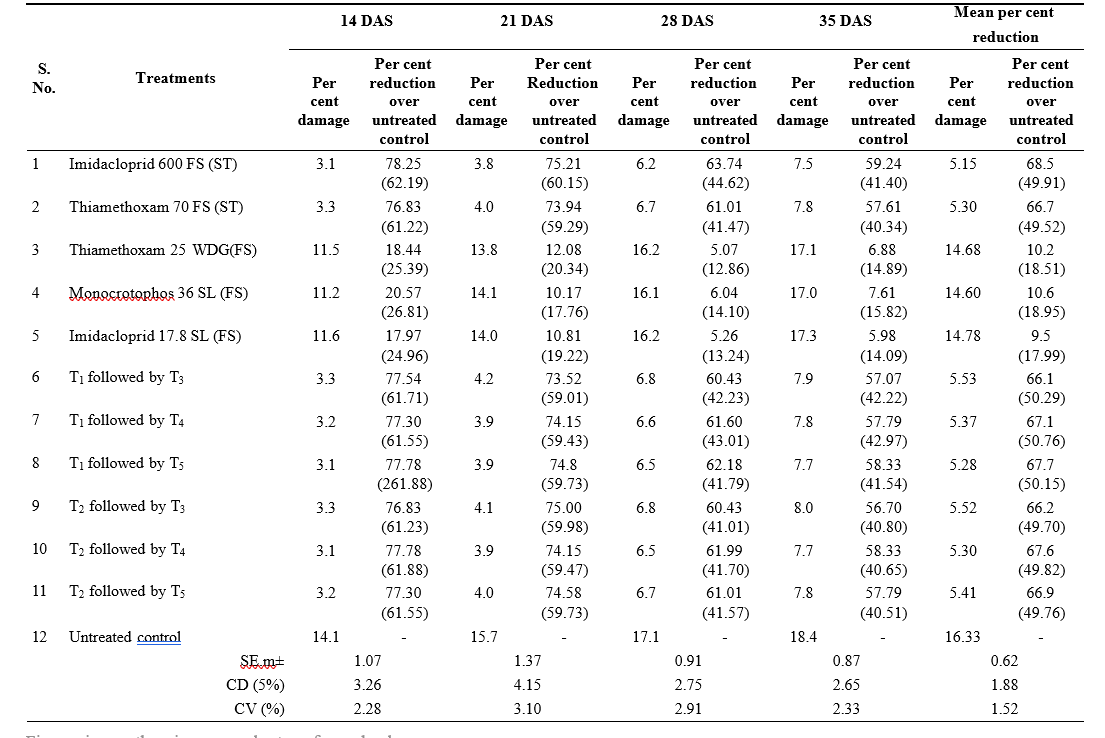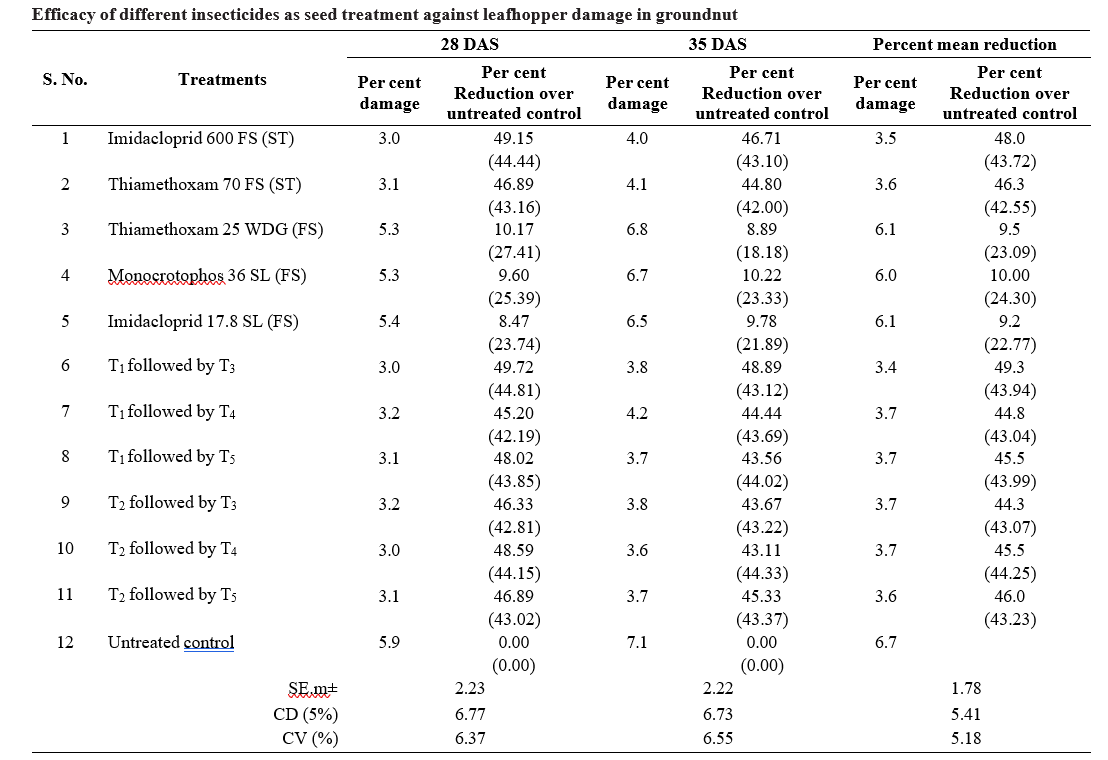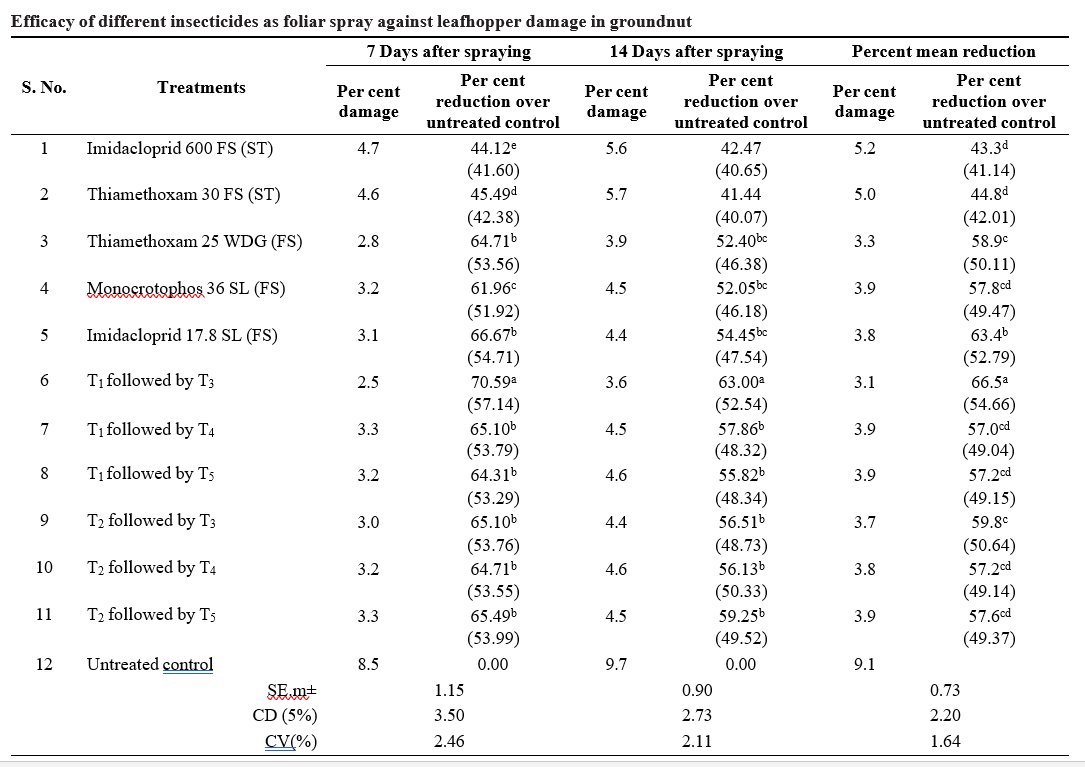Evaluation of Efficacy of Seed Treatment and Foliar Spray on Sucking Insect Pest Incidence in Groundnut
0 Views
P.V.L. PRAVALIKA*, K. DEVAKI, P. LATHA AND K. MANJULA
Department of Entomology, S.V. Agricultural College, ANGRAU, Tirupati-517 502.
ABSTRACT
Seed treatment was done at the time of sowing with imidacloprid 600 FS and thiamethoxam 30 FS. Among the different treatments, seed treated with imidacloprid 600 FS @ 2.0 ml kg-1 (+ 4 ml water) seed was found more effective in reduction of thrips and leafhopper damage followed by thiamethoxam 70 FS @ 2.0 g kg-1 seed when compared to untreated control. At 35 days after sowing, foliar spray was imposed to known the efficacy of foliar spray in groundnut against sucking pests. Among the different treatments imidacloprid 600 FS seed treatment + imidacloprid 17.8 SL spray (T8) and imidacloprid 600 FS seed treatment + thiamethoxam 25 WDG (T6) were the best treatments with 64.3 and 63.9 per cent reduction over control against thrips. The treatments imidacloprid 600 FS seed treatment + thiamethoxam 25 WDG spray (T6) and imidacloprid 17.8 SL spray (T5) were the best treatments with 66.5 and 63.4 per cent reduction over control against leafhoppers.
KEYWORDS: Groundnut, Seed treatment, Sucking pests Imidacloprid, Thiamethoxam.
INTRODUCTION
Groundnut (Arachis hypogaea L.) is one of the most important oilseed crops grown in India and contributes about 30 per cent of the total domestic supply of oil. Though India ranks first in area under groundnut cultivation, the productivity is quite low (1000 kg/ha) compared to that of USA (3000 kg/ha), China (2600 kg/ ha), Argentina (2100 kg/ha) and Indonesia (1550 kg/ha). It is grown on 5.09 million hectares in India, with annual production of 10.41 million tonnes. Gujarath (4.13 million tonnes) is the leading producer of groundnut followed by Rajasthan (1.93 million tonnes) and Tamil nadu (0.94 million tonnes). [Anonymous, 2020-21. DES, Ministry of Agri. & FW (DAC & FW) Govt of India]. In Andhra Pradesh groundnut crop is grown in an area of 7.74 million hectares with annual production of 0.84 million tonnes and productivity of 1426 kg-1 ha, majoring in Chittoor, Anantapur and Kadapa districts. The reason for low productivity of groundnut is due to biotic and abiotic stresses. Insect pests and diseases are the major biotic stresses for groundnut production. The sucking insect pest complex comprising thrips (Scirtothrips dorsalis Hood) and leafhopper (Empoasca kerri Pruthi) are the major pests of importance on groundnut particularly during summer seasons and bunch varieties are severely infested. Among the sucking pests attacking the groundnut crop, thrips species occur as a complex, starting from vegetative stage till the harvest of the crop. Objective of the present study is to evaluate the effectiveness of the seed dressing chemicals in order to develop an effective management strategies for leafhoppers and thrips in groundnut ecosystem.
MATERIAL AND METHODS
A field experiment was conducted to evaluate the relative “efficacy of seed treatment and foliar spray on sucking insect pest incidence in groundnut” at college farm, S.V. Agricultural College, Tirupati, Andhra Pradesh during kharif 2021 in randomized block design with twelve treatments of three replications. The groundnut variety Dharani was used as test variety which is susceptible to the insect pests. The groundnut seed was treated with insecticides viz., Imidacloprid 600 FS @ 2.0 ml kg-1 seed thiamethoxam @ 2.0 ml kg-1 seed (+ 4 ml water), For uniform covering of 1 kg seed, 5.0 ml of water was added to 1.0 ml of insecticide formulation and foliar spray was done at 35 DAS with thiamethoxam 25 WDG, imidacloprid 17.8 SL and monocrotophos 36 SL. Number of damaged leaves per plant dueto thrips and leafhoppers was recorded from five selected plants in each plot as per method suggested by Amin (1983). Data on per cent damage were subjected to angular transformation before statistical analysis. Per cent reduction of leaf damage by trips and leaf hoppers in treatments over control plots was estimated by using the formula given by Abbott (1925). The yield of groundnut was recorded from each plot and converted into yield per hectare.

RESULTS AND DISCUSSION
Foliar damage due to thrips at various intervals of seed treatment
Foliar damage due to thrips at 14 days after seed treatment
Foliar damage due to thrips was ranged from 3.1 to 14.1 per cent in different treatments. The seed treatment with imidacloprid (T1, T6, T7, T8) and thiamethoxam (T2, T9, T10, T11) recorded the lowest foliar damage compared to the treatments without seed treatment (T , T , T , T ).
Foliar damage 28 days after seed treatment
Highest per cent reduction over control was observed in plots treated with imidacloprid 600 FS @ 2 ml kg-1 seed and thiamethoxam 70 WP @ 2 ml kg-1 seed with 63.74, 62.18, 61.99, 61.60, 61.01 and 60.43 per cent reduction over control, respectively and all treatments were on par with each other. The treatments T3, T4 and T5 which are untreated with insecticides showed similar pest incidence as of control.
Foliar damage due to thrips at 35 days after seed treatment
The highest per cent reduction over control was observed in plots treated with imidacloprid 600 FS @ 2 ml kg-1 seed and thiamethoxam 70 FS @ 2 ml kg-1 seed The highest per cent reduction in thrips damage was observed in plots treated with imidacloprid 600 FS @ 2 ml kg-1 seed and thiamethoxam 70 WP @ 2 ml kg-1 seed with 78.25, 77.78, 77.54, 77.30, 76.83 and 76.60 per cent reduction over control, respectively and all treatments were on par with each other.
Foliar damage due to thrips at 21 days after seed treatment
Foliar damage at 21 days after treatment was ranged from 3.80 to 15.70 per cent in different plots. The highest per cent reduction over control was observed in plots treated with imidacloprid 600 FS @ 2 ml kg-1 seed and thiamethoxam 70 WP @ 2 ml kg-1 seed with 75.64, 75.42, 75.21, 75.00, 74.58, 74.15 and 73.52 per cent reduction over control, respectively and all treatments were on par with each other. The treatments T3, T4 and T5 which are untreated with insecticides showed similar pest incidence as of control. with 59.24, 58.33, 57.79, 57.61, 57.07 and 56.70 per cent reduction over control, respectively and all treatments were at par with each other. The current results are in conformity with the findings of Neetam et al. (2013) who evaluated the bio-efficacy of imidacloprid 600 FS when applied as seed treatment at the rate of 2 g a.i kg-1 seed proved most effective against the sucking pests up to four weeks of seed germination. The results were also in agreement with that of Venkateswarlu and Vemana (2015) who found that imidacloprid 600 FS @ 2.0 ml kg-1 seed proved more effective in reduction of thrips damage followed by thiamethoxam 30 FS. Bhadane et al. (2007) postulated that imidacloprid could be used as effective insecticidal treatment for the control of thrips in groundnut cropping system. Dey et al. (2005) and Sinha and Sharma (2007) also reported that imidacloprid provided effective control of early sucking pest complex such as aphids, leafhoppers, thrips and whiteflies at 25 days after sowing in okra.
Table 1. Details of insecticides used for seed treatment and foliar spray in groundnut against sucking pests during kharif, 2021-22

Efficacy of different insecticides as seed treatment against thrips damage in groundnut




Foliar damage due to thrips after spray
Effect of foliar spray on incidence of thrips in groundnut crop is presented in table 2. Highest per cent reduction in foliar damage due to thrips was recorded in imidacloprid 600 FS seed treatment + imidacloprid 17.8 SL spray (T8) followed by imidacloprid 600 FS seed treatment + thiamethoxam 25 WDG spray (T6) with 70.48 and 68.73 per cent over untreated control. Foliar damage by thrips at 14 days after spraying was ranged from 8.2 to 19.80 per cent, the highest per cent reduction in thrips damage was recorded in T8 (imidacloprid 600 FS seed treatment + imidacloprid 17.8 SL spray) and T6 (imidacloprid 600 FS seed treatment+ thiamethoxam 25 WDG spray) with 60.54 and 59.19 per cent reduction over untreated control From present study it was observed that the efficacy of seed treatment followed by sequential spray on groundnut, imidacloprid 600 FS seed treatment + imidacloprid 17.8 SL spray (T8) and imidacloprid 600 FS seed treatment+ thiamethoxam 25 WDG spray (T6) were the best treatments with 64.3 and 63.9 per cent reduction over control and the treatments were statistically at par with each other because of seed treatment at the sowing and foliar spray of insecticides at 35 DAS which shown better protection than the untreated control.
Pandiyan (2020) also reported that imidacloprid 17.8 SL @ 200 ml ha-1 was found to be effective in reducing thrips damage (16%) followed by thiamethoxam 25WG @ 200 g ha-1 (18%) as against 33% in untreated control. Khanpara et al. (2016) reported that spray of imidacloprid 200 SL @ 125 ml ha-1 or thiamethoxam 25 WG @ 200 g ha-1 or acephate 75 % SP @ 500 gm ha-1 at 15 days interval after initiation of pests were the most effective against thrips in groundnut.
Foliar damage due to leafhoppers at various intervals of seed treatment
Foliar damage at 28 Days After Seed Treatment
Leafhopper damage was absent during 14 and 21 days after seed treatment in all the treatments including untreated control due to weather conditions. Foliar damage due to leafhoppers was ranged from 3.0 to 5.9 per cent. The seed treatments with imidacloprid (T1, T6, T7, T8) and thiamethoxam (T2, T9, T10 ,T11) recorded the lowest foliar damage compared recorded the lowest foliar damage compared to the treatments without seed treatment (T3, T4, T5, T12).The highest per cent reduction over control was observed in plots treated with imidacloprid 600 FS @ 2 ml/kg seed and thiamethoxam 70 WP @ 2ml kg-1 seed with 49.72, 49.15, 48.59, 48.02,
46.89, 46.33 and 45.20 per cent reduction over control,
respectively and all treatments were on par with each other. The treatments T3, T4 and T5 which are untreated with insecticides showed similar pest incidence as of control.
Foliar damage 35 Days After Seed Treatment
Foliar damage at 35 days after treatment was ranged from 3.6 to 7.1 per cent. imidacloprid and thiamethoxam treated plots offered protection against leafhoppers. The highest per cent reduction over control was observed in plots treated with imidacloprid 600 FS @ 2 ml/kg seed and thiamethoxam 30 FS @ 2ml/kg seed with 48.89, 46.58, 46.12, 45.66 and 45.21 per cent reduction over control, respectively and all treatments were at par with each other.
Foliar damage due to leafhoppers after spraying
Foliar damage due to leaf hoppers at 7 days after spraying was recorded from 2.8 to 8.5 per cent. The highest per cent reduction over control was recorded in plots treated with imidacloprid 600 FS seed treatment + thiamethoxam 25 WDG spray (T6) was the best treatment with 70.59 per cent reduction over control. Foliar damage at 14 days after spraying was recorded from 3.6 to 9.7 per cent. The highest per cent increase in reduction over control among combination of seed treatment and spraying was recorded in plots treated with imidacloprid 600 FS seed treatment + thiamethoxam 25 WDG spray (T6) with 63.0 per cent reduction over control.
The present studies are also in confirmation with the finding of Baraiay and Vyas (2002) who reported that imidacloprid 0.006 per cent as foliar spray found to be effective against Empoasca keri Pruthi in groundnut with moderately economic. Application of imidacloprid
17.8 SL @ 0.5 ml l-1 was found superior over the other treatments with higher per cent reduction (85.21 per cent) of leafhoppers followed by thiamethoxam 25 WG @ 0.3 g l-1 on okra (Hemadri et al., 2018).
Among the different treatments, seed treated with imidacloprid 600 FS was found to be more effective in reduction of the thrips and leafhopper damage by followed by thiamethoxam 30 FS. At 35 days after sowing the plots treated with (T8) imidacloprid 600 FS seed treatment + imidacloprid 17.8 SL spray and imidacloprid 600 FS seed treatment + thiamethoxam 25 WDG (T6 ) spray were the next best treatments with 64.3 and 63.9 per cent reduction over control against thrips and for leafhoppers the plots treated with imidacloprid 600 FS seed treatment + thiamethoxam 25 WDG spray (T6) and imidacloprid 17.8 SL spray (T5) were the best treatments with 66.5 and 63.4 per cent reduction over control.
LITERATURE CITED
Anonymus, 2020-21. DES, Ministry of Agri. & FW (DAC & FW) Government of India.
Bhadane, R.S., Aghav, S.T., Sushir, M.A., Dharne, P.K and Patil, A.J. 2007. Bio-efficacy of Confidor 200 SL (Imidacloprid) against sucking pests on groundnut. Asian Journal of Biological Sciences. 2(1/2): 137-139.
Baraiay, K.P and Vyas, H.J. 2002. Efficacy of different insecticides against leafhopper, Empoasca kerri Pruthi on groundnut. Journal of Oilseeds Research. 19(2): 135-137.
Dey, P.K., Jana, S.K., Chakraborty, G and Somchoudhury, A.K. 2005. Evaluation of imidacloprid (70 WS and 20 SL) against sucking pest complex of okra, Abelmoschus esculentus. Journal of Entomological Research. 29(3): 215-218.
Hemadri, T., Vijaykumar, L., Somu, G and Sharanabasava. 2018. Management of leafhopper, Amrasca biguttula biguttula (Hemiptera: Cicadellidae) in okra (Abelmoschus esculentus) through new insecticide molecules. International Journal of Chemical Studies. 6(2): 687-690.
Khanpara, D.V., Parmar, G.M., Vikani, R.M and Dobariya, K.L. 2016. Evaluation of seed dressing chemicals for the management of sucking pests in summer groundnut (Arachis hypogaea L.). Journal of Oilseeds Research. 34(1): 23-25.
Neetam, H.K., Patil, S.P and Bagade, A.S. 2013. Bio- effiacay of insecticides as seed treatment against early sucking pests of soybean crop. Journal of Plant Development Sciences. 5(1): 28-34.
Pandiyan. I. 2020. Management of sucking pests in rabi/summer groundnut using newer molecule insecticides. Madras Agricultural Journal. 7(9): 314-319.
Venkateswarlu, N.C and Vemana, K. 2015. Efficacy of new insecticide imidacloprid FS 480 as seed dresser against thrips incidence on groundnut. Andhra Pradesh Journal of Agricultural Science. 1(1): 43- 46.
- Bio-Formulations for Plant Growth-Promoting Streptomyces SP.
- Brand Preference of Farmers for Maize Seed
- Issues That Consumer Experience Towards Online Food Delivery (Ofd) Services in Tirupati City
- Influence of High Density Planting on Yield Parameters of Super Early and Mid Early Varieties of Redgram (Cajanus Cajan (L.) Millsp.)
- Influence of Iron, Zinc and Supplemental N P K on Yield and Yield Attributes of Dry Direct Sown Rice
- Effect of Soil and Foliar Application of Nutrients on the Performance of Bold Seeded Groundnut (Arachis Hypogaea L.)

